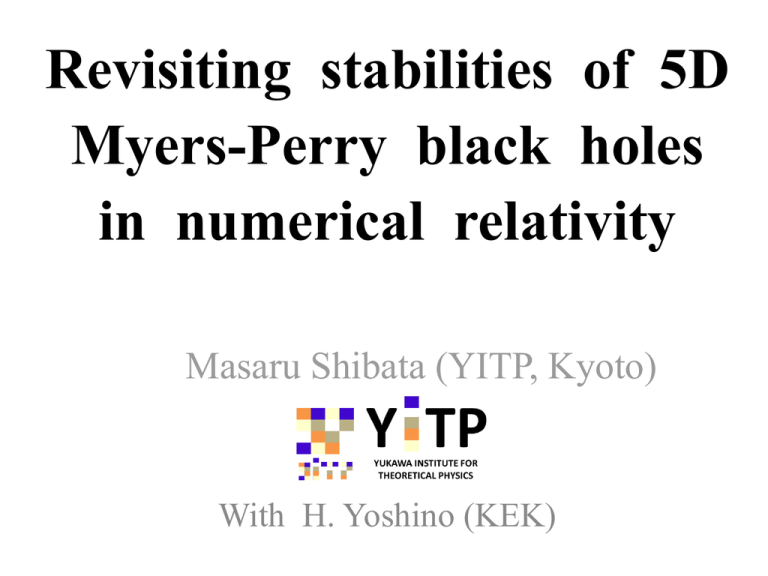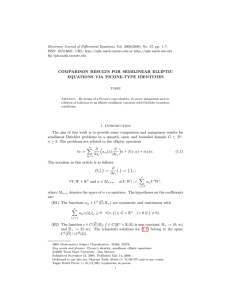Revisiting stabilities of 5D
advertisement

Revisiting stabilities of 5D Myers-Perry black holes in numerical relativity Masaru Shibata (YITP, Kyoto) With H. Yoshino (KEK) Myers-Perry black hole with single spin 2 Gd µ Σ 2 2 ds = −dt + d−5 dt + asin θ dϕ + dr + Σdθ 2 Δ r Σ + r 2 + a 2 sin 2 θ dϕ 2 + r 2 cos 2 θ dΩ2d−4 2 ( 2 ( ) ) % Gd µ ( 2 2 2 2 2 ' Σ = r + a cos θ ; Δ = r + a − d−5 * r ) & µ : mass parameter, a : spin parameter d − 2 Ωd−2 2 ⇒ M= µ, J = Ma 16π Gd d −2 2 parameters (µ , a) exist; but scale invariance exists a ⇒ q := : nondim. spin 1/(d−3) Gd µ ( ) ( ) 5D Myers-Perry BH: Reminder • Spin parameter q = a/µ1/2 = [0,1) # For q= 1, a naked singularity appears A =ΩD-2rh µ à 0 for q à 1 • For q à 1 , black hole is pancake-like Cp / Ceq à 0 Cp(φ) “Axial ratio” Ceq 1 ηm = Cp ϕ exp imϕ d ϕ ∫ Cp “Deformation” ( ) ( ) Previous studies for the stability of MP BH (1) • Emparan & Myers gave a conjecture based on Thermodynamical argument (2003) ? M, J fixed A =ΩD-2rhµ à 0 for high-spin A = 2Ao >0 Likely to be more stable • High-spin BH seems to be unstable for any dimension including D=5 case with q ~ 1 Previous studies for the stability of MP BH (2) • Is higher-dimensional spinning BH unstable ? • Yes, for more than 6D cases: Consensus ü For axisymmetric perturbation (Dias et al. 09) ü For non-axisymmetric case (SY 10, Dias + 14) • But, could be “No” for 5D case ü For axisymmetric perturbation, it is No ü SY 10 suggested in numerical relativity it could be “Yes” à However, simulation time was too short à We have been revisiting since last year ü Dias + 14 show it “No”. II Summary of our previous higherdim numerical-relativity results: • Use BSSN formulation with cartoon method: impose SU(D-3) symmetry for extra-dim space • Excise a region deep inside horizon • Fixed mesh refinement algorithm • “Puncture gauge” with appropriate choice of coefficients ∂tα = −1.5α K 1 i i ∂t β = B 3 CB i i i ∂t B = Γ − B : C B = 1− 2 µ Evolution of deformation of AH: 6D (SY10) Unstable Deformation (m=2) The result does agree with Dias+ 14 q=0.74 Marginal Evolution of deformation of AH: 7D (SY10) q=0.96 Unstable Deformation (m=2) The result does agree with Dias+ 14 q=0.735 6D Evolution of Cp / Ce for high spin Axial ratio SY10 q ~ 0.6 Critical value =NOT very small q=0.74 q > 0.74 q~1 Cp Ce SY10 Looks exponential Crash growth Stable Exponential decay Unstable? Deformation (m=2) Evolution of deformation of AH in 5D The result does not agree with Dias+ 14 III New numerical simulations • Long-term simulations are obviously required for high-spin case; this will be the case for studying black ring • Employ Z4c formulation in which constraint violation can propagate • For 4D black holes, Z4c has been proven to be robust for evolving high-spin BHs for a long term Z4c formulation (Bernuzzi & Hilditch): 5D version 1 l l (∂t − β ∂l )γ ij = −2α Aij + γ il β ,j + γ jl β ,i − γij β l ,l 2 Vacuum χ l l (∂t − β ∂l ) χ = α K − β ,l 2 # & # & 1 1 l (∂t − β ∂l ) Aij = αχ % Rij − γ ij R ( − χ % Di D jα − γ ij Δα ( 4 4 $ ' $ ' 1 l l l l +α KAij − 2 Ail A j + Ail∂ j β + A jl∂i β − β ,l Aij 2 # 1 2& l ij (∂t − β ∂l ) K = α % Aij A + K ( − Δα : K = K − 2Θ 4 ' $ # i jk 1 ij & k i ij ∂t − β ∂k Γ = 2α % Γ jk A − γ 3K − 4Θ − 2 χ , j A ( ,j 4 $ ' 1 i j 1 ik j j i jk i − Γ β, j + Γ β, j + γ β, jk + γ β, jk 2 2 1 l (∂t − β ∂l )Θ = α H : H = R + K 2 − Ki j K ij 12 2 l ( ) ( ( ) ) ( ( ) ) Essence of Z4C formulation (Bernuzzi & Hilditch) H = 0 : Hamiltonian constraint H i = 0 : Momentum constraint %' ADM, BSSN: ∂ H ~ −D H i , ∂ H i ~ 0 t i t ⇒& '( Z4c: ∂t Θ ~ H , H i ~ −∂i Θ ⇒ ∂t H ~ −Di H i , ∂t H i ~ −D i H Constraint violation obeys wave equations ADM, BSSN: constraint violation cannot propagate Z4C: constraint violation can propagate à “error” is washed out à long-term simulation 13 1 Evolution of bar-mode (m=2): Add bar perturbation and evolve as SY10 0.1 m=2 Preliminary 0.01 q=0.92 q=0.915 q=0.91 q=0.90 q=0.89 2 (t-1.5) The growth are not exponential q=0.92 r a e n i l . x Appro q=0.915 q=0.91 q=0.90 0.001 q=0.89 Numerical results agree with Dias+ 14 (black dot-dot) 0.0001 0 0 1/2 50 t/µ 1/2 50 t/µ 1 Study for Bar-mode (m=2 mode) • For stable BHs, q < ~0.90, oscillation frequency and damping rate agree with Dias+ 14 e.g., ωr ~ 1.3, ωi ~ 0.028 for q = 0.90 à For q < =0.90, 5D BH are stable (our previous analysis was incorrect) However, for q > ~0.91, we s2ll find an instability à This is associated with other unstable mode. Axial ratio of horizon Cp / Ceq 2 Evolution of axial ratio with no initial perturbation: Instability is not due to m=2 0.38 0.37 0.36 0.35 0.34 0.33 0.32 0.31 0.3 0.29 0.28 q ~ 0.875 Stationary states q ~ 0.89 Looks stable q = 0.90 q = 0.91 q=0.900 q=0.910 q=0.915 q=0.920 q = 0.92 0 Preliminary 50 100 150 1/2 tt // (µ µ1/2 ) 200 250 300 0.3 Evolution of the shape of apparent horizon t=65.5 t=75.8 q=0.92 0.3 0.2 0.1 0.1 0 0 y 0.2 -0.1 -0.1 -0.2 -0.2 -0.3 -0.3 Preliminary t=86.0 -0.3 -0.2 -0.1 0 0.1 0.2 0.3 This is not gauge-invariant. -0.3 -0.2 -0.1 0 0.1 0.2 0.3 x But, it may show something. x t=96.3 t=106.5 0.3 0.2 0.2 0.2 0.1 0.1 0.1 0 0 0 y 0.3 y 0.3 -0.1 -0.1 -0.1 -0.2 -0.2 -0.2 -0.3 -0.3 -0.3 -0.3 -0.2 -0.1 0 0.1 0.2 0.3 -0.3 -0.2 -0.1 0 0.1 0.2 0.3 -0.3 -0.2 -0.1 0 0.1 0.2 0.3 x x x m=4 mode perturbation by Cartesian grid q=0.900 q=0.910 q=0.915 q=0.920 q=0.925 0.1 m=4 Preliminary Stable Unstable !? 0.01 Noise level 0.001 0.0001 0 50 100 Growing mode still exists: Real frequency is by 10% smaller than in linear analysis for it 150 1/2 1/2 tt// µµ 200 250 300 Cp / Ceq Results depend only weakly on resolution 0.38 0.37 0.36 0.35 0.34 0.33 0.32 0.31 0.3 0.29 0.28 q=0.92 à ~ 0.875 Stable q=0.92:Unstable !? q=0.90 N=60,q=0.92 N=48,q=0.92 N=40,q=0.92 N=60,q=0.90 N=48,q=0.90 N=40,q=0.90 q=0.92 0 Preliminary 50 100 t/µ 1/2 150 200 r+exact --11 Ar+AH/ /A exact Evolution of area of apparent horizon 0.14 0.12 0.1 0.08 0.06 0.04 0.02 0 -0.02 q=0.92, Unstable ? q=0.900 q=0.910 q=0.915 q=0.920 q=0.915, Unstable ? q=0.91, Unstable ? q=0.90, Stable 0 Preliminary 50 100 150 1/2 tt // µ1/2 200 250 300 Checking 1st law of BH thermodynamics ( 2 1/2 ) µ−a rh κδ A = 8π δ M − ΩHδ J > 0 : κ = = µ µ Assume monotonic wave emission ω q ⇒ δ M = σδ J : σ = ; Here, ΩH = 1/2 > σ is needed m µ % 3 δµ " 1 $$ ⇒ δq = − q '' 1/2 2 µ #µ σ & 1/2 µ σ − ΩH δA δq δ q σµ1/2 − q ⇒ = = 2 1/2 A 1− q 1− σµ q 1− q2 1− σµ1/2q ( ) ( ) I checked this relation between δA & δq is satisfied for m=4 approximately: σ ~ 0.8 Summary • Z4c formalism enables us long-term simulations • For q < =0.9, 5D Myers-Perry BH appears stable (I am very sorry for our previous result): This new result agrees with Dias+ 14 i.e., our results for ωr & ωi agree with Dias+ 14 • However, simulations still find a non-axisym. instability (m=4) for 5D high-spin MP BH !?!? v New possible critical value is q ~ 0.91 (a/rh ~ 2.2) v The instability is NOT associated with bar-mode v Unstable BH evolves to a less spinning BH Ø To be honest, I do not still believe this result: Please do not believe as well … A concern • Theory in Z4c formalism is different from GR in the presence of a constraint violation • If a large constraint violation is continuously generated (e.g., near the BH horizon), something wrong such as bypassing might occur • We have to be careful and need more studies Prohibited in GR Another solu2on Direc2on of constraint viola2on A solu2on Solution space in GR A concern in Z4c formulation 1 l l (∂t − β ∂l )γij = −2α Aij + γil β ,j + γ jl β ,i − γij β l ,l 2 χ l (∂t − β ∂l ) χ = α K − β l ,l 2 # & # & 1 1 l (∂t − β ∂l ) Aij = αχ % Rij − γ ij R ( − χ % Di D jα − γ ij Δα ( 4 4 $ ' $ ' l ( ) 1 Add +α ( K + nΘ)Aij − 2 Ail A lj + Ail∂ j β l + A jl∂i β l − β l ,l Aij 2 constraint # 1 2& l ij (∂t − β ∂l ) K = α % Aij A + K ( − Δα : K = K − 2Θ ( $ ) 4 ' # i jk 1 ij & k i ij ∂t − β ∂k Γ = 2α % Γ jk A − γ 3K − 4Θ − 2 χ , j A ( ,j 4 $ ' 1 i j 1 ik j j i jk i − Γ β, j + Γ β, j + γ β, jk + γ β, jk 2 2 1 l (∂t − β ∂l )Θ = α H : H = R + K 2 − Ki j K ij 2 ( ) ( ( ) ) 24 Cp / Ceq Final state depends on n for q=0.92 Need more researches 0.44 0.42 0.4 0.38 0.36 0.34 0.32 0.3 0.28 Z4c n=-1 n=1 n=2 q=0.90 q=0.92 0 Preliminary 50 100 t / µ1/2 150 200 No spin: Check of 4th-order convergence AAH / Aexact - 1 1/2 / N Δx=1.2=µ x=1.2µ1/2/N 0 -0.01 -0.02 -0.03 -0.04 -0.05 -0.06 -0.07 -0.08 N=30 N=24 N=20 4 N=24, (4/5) N=20, (2/3)4 0 200 400 t/µ 600 1/2 800 1000

